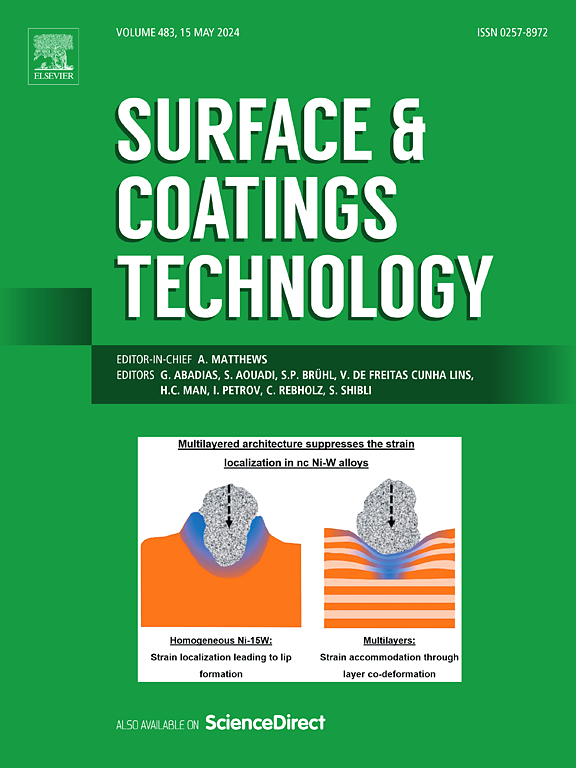Thermal degradation resistance of HVOF-sprayed Cr3C2–NiCr composite coatings under oxidizing and corrosive environments
IF 5.3
2区 材料科学
Q1 MATERIALS SCIENCE, COATINGS & FILMS
引用次数: 0
Abstract
Metallic systems working at high temperatures are exposed to severe chemical degradation mechanisms, including oxidation and hot corrosion, which lead to performance losses and major decreases in service life. In this study, Woka 7202 powders with Cr3C2–25(80Ni![]() 20Cr) composition were coated on a 316 L stainless steel substrate by the HVOF (High Velocity Oxy-Fuel) technique. The coatings were subjected to isothermal oxidation tests at 900 °C (5, 25, 50 and 100 h) and hot corrosion tests (1, 3 and 5 h) in an aggressive atmosphere containing 55 % V2O5 + 45 % Na2SO4. SEM, EDS and XRD investigations showed that the coating created a thin and stable oxide layer that was continuous at high temperatures and efficiently protected the substrate by keeping its structural integrity during hot corrosion conditions. This comprehensive study covering long-term and multiple conditions, which is rare in the literature, reveals the microstructural stability of the coating in detail and scientifically supports that Cr3C2-NiCr based HVOF coatings can be an effective protective barrier in high temperature applications.
20Cr) composition were coated on a 316 L stainless steel substrate by the HVOF (High Velocity Oxy-Fuel) technique. The coatings were subjected to isothermal oxidation tests at 900 °C (5, 25, 50 and 100 h) and hot corrosion tests (1, 3 and 5 h) in an aggressive atmosphere containing 55 % V2O5 + 45 % Na2SO4. SEM, EDS and XRD investigations showed that the coating created a thin and stable oxide layer that was continuous at high temperatures and efficiently protected the substrate by keeping its structural integrity during hot corrosion conditions. This comprehensive study covering long-term and multiple conditions, which is rare in the literature, reveals the microstructural stability of the coating in detail and scientifically supports that Cr3C2-NiCr based HVOF coatings can be an effective protective barrier in high temperature applications.
hvof喷涂Cr3C2-NiCr复合涂层在氧化和腐蚀环境下的耐热降解性能
在高温下工作的金属系统暴露在严重的化学降解机制下,包括氧化和热腐蚀,这会导致性能损失和使用寿命的大幅降低。本研究采用HVOF (High Velocity oxygen - fuel)技术将含有Cr3C2-25 (80Ni20Cr)成分的Woka 7202粉末涂覆在316 L不锈钢基体上。在含有55% V2O5 + 45% Na2SO4的腐蚀性气氛中,对涂层进行900°C(5、25、50和100 h)等温氧化试验和1、3和5 h热腐蚀试验。SEM、EDS和XRD研究表明,该涂层形成了一层薄而稳定的氧化层,在高温下连续存在,并在热腐蚀条件下有效地保护基体,保持其结构完整性。这项长期、多条件、文献罕见的全面研究,详细揭示了涂层的微观结构稳定性,科学地支持了Cr3C2-NiCr基HVOF涂层在高温应用中是一种有效的防护屏障。
本文章由计算机程序翻译,如有差异,请以英文原文为准。
求助全文
约1分钟内获得全文
求助全文
来源期刊

Surface & Coatings Technology
工程技术-材料科学:膜
CiteScore
10.00
自引率
11.10%
发文量
921
审稿时长
19 days
期刊介绍:
Surface and Coatings Technology is an international archival journal publishing scientific papers on significant developments in surface and interface engineering to modify and improve the surface properties of materials for protection in demanding contact conditions or aggressive environments, or for enhanced functional performance. Contributions range from original scientific articles concerned with fundamental and applied aspects of research or direct applications of metallic, inorganic, organic and composite coatings, to invited reviews of current technology in specific areas. Papers submitted to this journal are expected to be in line with the following aspects in processes, and properties/performance:
A. Processes: Physical and chemical vapour deposition techniques, thermal and plasma spraying, surface modification by directed energy techniques such as ion, electron and laser beams, thermo-chemical treatment, wet chemical and electrochemical processes such as plating, sol-gel coating, anodization, plasma electrolytic oxidation, etc., but excluding painting.
B. Properties/performance: friction performance, wear resistance (e.g., abrasion, erosion, fretting, etc), corrosion and oxidation resistance, thermal protection, diffusion resistance, hydrophilicity/hydrophobicity, and properties relevant to smart materials behaviour and enhanced multifunctional performance for environmental, energy and medical applications, but excluding device aspects.
 求助内容:
求助内容: 应助结果提醒方式:
应助结果提醒方式:


